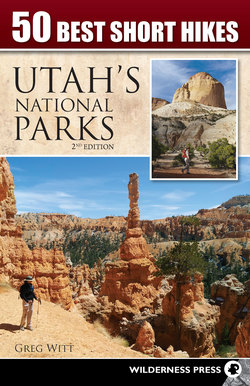Читать книгу 50 Best Short Hikes in Utah's National Parks - Greg Witt - Страница 29
На сайте Литреса книга снята с продажи.
Оглавление7 Fiery Furnace
Trailhead Location: Fiery Furnace Viewpoint parking area
Trail Use: Walking, hiking
Distance & Configuration: Approximate 2.0-mile hike
Elevation Range: 4,766' at trailhead with typical elevation gain/loss of 200'–300'
Facilities: Vault toilet at trailhead
Highlights: A labyrinth of fins and slots, secret passageways, and impossible dead-ends—an Arches treasure
DESCRIPTION
The name Fiery Furnace comes not from the scorching summer sun—actually, you’ll find plenty of shade here—but from the fiery red hues of the rock and the flamelike contour of the sandstone fins. The Fiery Furnace is compact—less than a mile long and never more than 0.5 mile wide. But in that maze of tightly formed fins, it’s easy to get lost, or at least briefly disoriented. That’s why hikers must join a guided hike or obtain a special permit to enter Fiery Furnace. The rule is as much for the protection of the native plants and soils as it is for the safety of inexperienced hikers. If you’ve never hiked in Fiery Furnace previously, it is strongly recommended that you join a ranger-led hike.
During the busy season, rangers lead 3-hour, moderately strenuous hikes through the Fiery Furnace. Tickets for this guided hike must be obtained in advance for a fee. But remember that the rangers are guides, not Seeing Eye dogs, so you’ll still need to take a measure of personal responsibility and preparation. Wear good hiking shoes with gripping soles; no sandals or high-heeled shoes are allowed. Each hiker must bring at least 1 quart of water carried in a small pack with your other gear, so your hands are free to navigate some often-challenging terrain.
On the guided hike you need to traverse narrow ledges with steep drop-offs, do some basic climbing maneuvers on irregular and broken sandstone, and be able to jump across gaps and fissures between the fins. Once you enter the Fiery Furnace, each member of the guided group must commit to complete the hike. Because of these demands, children younger than age 5 are not permitted, and children younger than 12 must be accompanied by an adult. Tickets for joining the guided hike may be purchased in advance on the park’s website, nps.gov/arch.
ROUTE
Fiery Furnace is a uniquely Arches experience, a hike with no trail, no route, no cairns, no destination, no map, and no signs—in short, there’s nothing like it anywhere else in the park.
If you’ve previously hiked Fiery Furnace with a guided group and completed a training session at the visitor center, you may be issued a special-use permit to enter Fiery Furnace as an independent hiker, but you are strongly encouraged to go with a ranger-guided group whenever possible.
If you’re on your own, you can make your descent into the Fiery Furnace from either the northeast or southeast side of the parking area. Along any of the three well-beaten trails you’ll arrive at the fringe of the Fiery Furnace within 200 yards. Once you’ve entered, the parking area and trailhead are out of view, so you’ll need to rely on a keen sense of direction to find your way back.
If you do get disoriented or lost, the best advice is to head in a westerly direction, which will ensure that you cross the Arches Scenic Drive at some point rather than wandering off into the desert. But just walking west is more easily said than done, because all the fins in the Fiery Furnace run northwest–southeast and create a significant barrier to crosswise travel.
TO THE TRAILHEAD
GPS Coordinates: N38º 44.594' W109º 33.948'
From the Arches Visitor Center, drive 14.5 miles along Arches Scenic Drive to the Fiery Furnace Viewpoint parking area on the right.
HOW DO FINS FORM?
The majestic fins of Fiery Furnace
The fins in Arches National Park formed from forces above and below the surface. A thick layer of subsurface salt buckled and liquefied, causing the overlaying rocks to shift. Above the surface, wind and water eroded and carved the rock. Water that seeped into cracks froze, expanded, and broke off chunks. The cracks continued to expand, creating fins, the product of a harsh and active desert environment.
